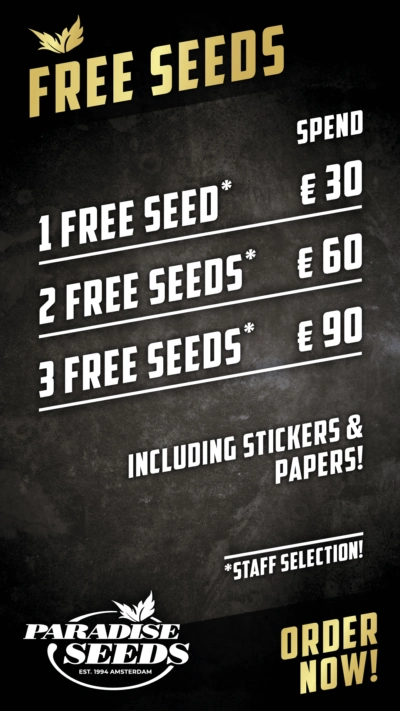This month sees the annual celebration of cannabis culture! So this month we are taking a look at five events which have changed 420 cannabis history. Just like every year Paradise Seeds is joining the festivities with a week full of promos and prizes to mark this year’s occasion. Participation in this cannabis related occasion was a niche activity for many years, ignored by the mainstream, but now even the ‘straight’ media is recognizing the fact that 420 is ‘a thing’ – even if it does ask questions like ‘why is 420 important to stoners?’ and ‘why does 420 stand for weed?’
On Tuesday 20 th April at the fateful hour of 4.20pm there will be multiple doobies lighting up around the world to mark the occasion. We’ve told the story of 420 before, so this year we thought we would pick out some of the biggest events in 420 cannabis history that have contributed to this special state of mind.
*We take as our Ground Zero for this 420 cannabis history lesson, the 1961 United Nations Single Convention on Narcotic Drugs which effectively outlawed cannabis around the world.
Cannabis history: The Dutch Opium Act revision 1976
In 1976 a change in the law opened the way for the tolerance of hash and weed in the Netherlands, which set the scene for the development of the modern day cannabis industry. The 1976 revision altered the original Opium Act (1919) and created two distinctive categories – ‘hard’ and ‘soft’ drugs, based on a ‘risk scale’ that considered data relating to medical, pharmacological, sociological and psychological factors.
From that point onwards the coffee shop became a safe haven for cannabis consumers, who were able to purchase and use cannabis on the premises. Initially most of the cannabis consumed was hashish, imported from countries like Morocco, Pakistan and Lebanon, but during the 1980s good quality (domestically produced) marijuana became more widely available on the coffee shop scene. It was against this background that Paradise Seeds founder and master breeder, Luc Krol, began experimenting with cannabis breeding, eventually setting up Paradise Seeds in 1994.
Cannabis science discovery: The Human Endocannabinoid System 1992
This discovery provided the starting point for the development of medical cannabis as we know it and built on scientific research which had established the existence of receptors in the human brain responsive to compounds found in cannabis (like THC and CBD). It was in 1992 that the pieces of the puzzle came together through the work of Dr. Lumir Hanus and Dr. William Devane at the Hebrew University in Jerusalem.
While studying endocannabinoids, they stumbled on the existence of a molecular signaling system in the body, which was responsible for regulating a myriad of biological functions, whose purpose was to maintain the body’s balance and stability against external environmental fluctuations. This was termed the endocannabinoid system.
Medical cannabis victory: Proposition 215, 1996
While the Californication of cannabis legalization symbolizes the march towards acceptance of cannabis, this landmark change in the law in the USA’s Golden State (celebrated by the release of Paradise Seeds’ Californian Gold strain) would not have been possible without Proposition 215. Also known as The Compassionate Use Act of 1996, 215 legalized the possession and cultivation of cannabis by patients with a recommendation from their physician. It was the result of extensive campaigning by medical cannabis advocates who were motivated by the therapeutic benefits of cannabis in relation to symptoms of the disease AIDS.
Historical cannabis landmark: Uruguay Legalizes Weed, 2013
This milestone makes the list partly because the president who signed recreational weed into law was such a dude! Jose Mujica , was a former guerrilla and a farmer who was one of the most humble politicians to hold the highest office in recent times – right down to his simple country home and crappy old car he drove! His rationale was that by legalizing cannabis the country would starve the oxygen of the drugs cartels. It was a gamble, as legalization was in breach of the 1961 UN convention and risked sanctions being levied by other member states.
However, his bold move opened the door to other countries legalizing and gave the Southern Hemisphere a cannabis champion. Neighboring countries in South America, including Chile where Paradise Seeds varieties supplied one of the continent’s largest legal grows ( Chile Grows Huge – High Times ).
Historical cannabis policy change: Canada Legalizes Weed, 2018
Yes the USA is bigger – with recreational cannabis legal in 15 states and the District of Columbia and medical cannabis legal in 35 – but at Federal level weed still remains illegal. Canada’s 2018 legalization could be argued as being more significant because it is a nationwide policy. As one of the G7 nations the legalization experiment could also provide a working model that other democracies would be interested in emulating. Just as significant is the fact that, despite teething problems, Canada’s legalization policy appears to be showing some success .
For this reason, our 420 prediction is that, as the effects of covid are felt on economies around the world, the Canadian model may well fuel another legalization boom in the next couple of years. As for when 420 becomes an official national holiday?… Well for now that’s no more than a happy pipe dream!


